


AN/ULQ-21 COUNTERMEASURES SET
The ULQ-21is a fully programmable ECM set that generates 24 ECM modes and
innumerable combinations of these modes. The ULQ-21is designed for multipurpose
use in targets, aircraft internal or external stores, shipboard applications,
laboratory applications, and at land-based instrumentation sites. The ULQ-21
countermeasures set is the follow-on to the DLQ-3C and consists of several
interchangeable modules whose numbers continually increase with ongoing system
developments. Its modularity allows for the configuration versatility and
flexibility to meet many different mission, application, and installation
requirements.
The AN/ULQ-21(V) (ULQ-21) Countermeasures (CM) Set offers a highly versatile ECM
system which can be used to simulate the continually evolving and advancing ECM
threat environment.
The ULQ-21 is a digital, fully computer-controlled and programmable ECM system
operating in the frequency range of 1 to 18 GHz with special applications in the
Ka-Band (36 GHz). It is the follow-on to the AN/DLQ-3C(V) CM Set and is designed
for multipurpose use in targets, aircraft external stores, aircraft internal
installations, laboratory applications, and land-based instrumentation sites.
The ULQ-21 is capable of generating noise, deception (repeater), transponder, and
combination ECM techniques. Its present ECM capability allows manned aircraft
and unmanned aerial targets to simulate observed and projected ECM threats
through the year 2010.
Not only does the ULQ-21 provide generic threat simulation capability, but it
also serves as the baseline for several replica-grade simulators. Most
importantly, it provides all the ECM techniques and parameters contained in the
Electronic Counter-Countermeasures Requirements and Assessment Manual (ERAM)
engagement models.
The current ULQ-21 CM Set consists of several interchangeable modules. Its
modularity allows for configuration versatility and flexibility to meet many
different mission, application, and installation requirements.
Through numerous transmitter and antenna configurations, the ULQ-21 allows
versatile power and gain variations and spatial coverage. One unique antena
configuration is the special transmit antenna. Consequently, by using
combinations of the described modules, the ULQ-21 CM Set can be tailored to fit
specific needs.
The number of ULQ-21 modules continuously increases with ongoing system
development. Currently, the ATST is developing miniaturized payloads for smaller
aerial targets such as the BQM-74. These efforts include the development of an
advanced noise generator, IFM noise alternative, advanced VDA, miniature RGS
box/receiver, and miniature PM controller.
CONFIGURATIONS
Common AN/ULQ-21(V) Configurations
| Operating Band | |
|
I |
I |
I |
I |
I |
I
| I
| I
| I
| G/H
| G/H
| G/H
| E/F
| E/F
| E/F
| J |
J |
J |
C/D |
C/D |
C/D |
|---|
|
|
| WCO | |
|
X |
X |
X |
X |
X |
X |
|
X |
X |
X |
X |
X |
X |
X |
X |
X |
X |
X |
X |
X |
X |
|---|
| VDA | |
X |
X |
X |
X |
X |
|
X |
X |
|
|
|
|
|
|
|
|
|
|
|
|
|
|
| MM | |
|
|
|
|
X |
X |
|
|
|
X |
|
|
X |
|
|
X |
|
|
X |
|
|
X |
| PM | |
X |
|
|
|
|
|
|
|
|
|
|
|
|
|
|
|
|
|
|
|
|
|
| WG | |
|
X |
|
|
|
|
|
|
X |
X |
|
X |
X |
|
X |
X |
|
X |
X |
|
X |
X |
| STA | |
|
|
X |
|
|
|
X |
X |
|
|
|
|
|
|
|
|
|
|
|
|
|
|
| RT | |
|
|
|
X |
|
|
|
|
|
|
|
|
|
|
|
|
|
|
|
|
|
|
| MTDA | |
|
|
|
|
|
|
|
|
X |
X |
|
X |
X |
|
X |
X |
|
X |
X |
|
X |
X |
| SSA | |
|
|
|
|
|
|
|
X |
|
|
|
|
|
|
|
|
|
|
|
|
|
|
| 100W TWTA | |
X |
X |
X |
X |
X |
X |
X |
|
X |
X |
X |
X |
X |
X |
X |
X |
X |
X |
X |
X |
X |
X |
| MPM | |
|
|
|
|
|
|
|
|
|
|
|
|
|
|
|
|
|
|
|
|
|
|
Although a B-Band configuration is not shown,
B-Band noise techniques are available using an ALT-41 transmitter. In addition,
all configurations are available with a 5 W FM/FM telemetry pack with six
channels of discrete information, called the telemetry transmitter.
Selected combinations of the individual modules determine the parameters and
characteristics of the ECM technique. The ability to add and remove these
modules makes it possible for the ULQ-21 to effectively meet the broad spectrum
of threat requirements in the ECM environment. This modular design also provides
an economic advantage by using only those components required for a particular
installation and specific threats. Finally, the ULQ-21's versatility and
simplicity permit easy adaptation to any follow-on development with a minimum
impact on system configuration and logistics support.
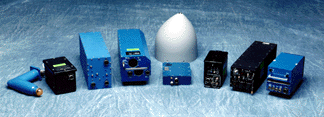
ULQ-21 In Pod Tray Configuration
ECM TECHNIQUES
The noise techniques attempt to mask the illuminating radar's return signal with
a larger power signal. These techniques utilize the internal noise source to
generate the RF signal. The deception and transponder techniques attempt to
provide false information (range, angle, or velocity) to the weapon system in
order to degrade or break the weapon system or missile track. The resultant
signal is then amplified to produce a larger signal to the radar than the actual
radar return.
Although most modules are capable of stand-alone operation, they can also be used
together to form unique ECM techniques. Particular technique characteristics or
capabilities of one module combined with those of another module will determine
the parameters and characteristics of the unique ECM technique. In addition,
when the modules are used in the overall system and combined with antenna-based
techniques, it can result in over 9,000 possible mode/technique combinations.
ECM Module Applications
| WCO Modes | VDA Modes | RR/MM Modes | Antennas |
|---|
| BN | DN | SP | TB |
| CN | RD | ASN | CP |
| FTG | BDN | MFT | HOR |
| MFR | MFR | PLD | VER |
| RGS | VGS | STBY | SXP |
| STBY | RPTR | RGS SP | |
| RPTR | STBY | VGS SP | |
| NSAM | NBRN | RGS MFT | |
| SWPT | HO&H | RGS PLD | |
| RSAM | RSAM | VGS MFT | |
| RGS & SAM | RCDB | VGS PLD | |
| FTG & SAM | VGS & SAM | RGS & VGS PLD | |
| FTG & SAMH | | VGS & RGS SP | |
| RGS & SAMH | | RGS & VGS MFT | |
Key to Acronyms
| ASN | Automatic Spot Noise | MFT | Multiple False Targets | SAM | Swept Amplitude Modulation |
|---|
| BDN | Blinking Doppler Noise | NBRN | Narrow Band Repeater Noise | SAMH | SAM Hold |
|---|
| BN | Blinking Noise | NSAM | Noise with SAM | SP | Stretched Pulse |
|---|
| CN | Continuous Noise | PLD | Pipeline Delay | STBY | Standby |
|---|
| CP | Circular Polarized | RCDB | Repeater Countdown Blink | SWPT | Swept Noise |
|---|
| DN | Doppler Noise | RD | Random Doppler | SX | Swept Cross Polarization |
|---|
| FTG | False Target Generator | RGS | Range Gate Stealer | TB | Terrain Bounce |
|---|
| HO&H | Hold Out & Hook | RPTR | Repeater | VER | Vertical Polarization |
|---|
| HOR | Horizontal Polarization | RSAM | Repeater with SAM | VGS | Velocity Gate Stealer |
|---|
| MFR | Multiple Frequency Repeater |
|---|
AN/ULQ-21(V) Telemetry Transmitter
A unique member of the AN/ULQ-21(V) product line is the telemetry (TM)
transmitter. It is a tunable S-Band frequency modulation transmitter that is
primarily used to send data from airborne AN/ALQ-167(V) Electronic
Countermeasures (ECM) pods to ground stations for analysis. It provides
real-time TM data from the pods during training and live-firing missions. The
transmitted information is used during flight missions to determine the operating
conditions of the pods and the accuracy of various parameters. Because the
transmitter is tunable, it can be used in missions that require the use of ore
than one pod (i.e., missions that require multiple TM frequencies).
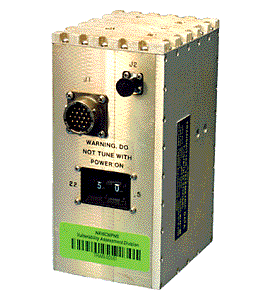
ULQ-21 Telemetry Transmitter
T-1487/ALT-41 CM Transmitter
The ALT-41 CM Transmitter is used in the ALQ-167 to transmit RF signals during
noise jamming modes of operation. The ALT-41 CM Transmitter transmits at 425 to
445 MHz.
The waveform generator (WG) is a video signal generator. It provides a stable
timing signal to synchronize the blinking of two different ECM systems on
separate platforms at frequencies between 0.006 and 50 Hz and a duty cycle of 50
percent.
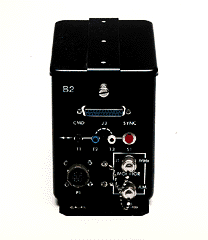
Waveform Generator
The polarization modulator (PM) provides nonadaptive swept cross polarization
angle jamming techniques. The modulator, consisting of a PM controller and a
transmit antenna, provides an output sweep time of 0.1 to 2.0 Hz and a sweep
angle of ± 2° to ± 45°. The PM generates one of three
polarization modes to the PM antenna which is simultaneously receiving the
selected ECM technique output of the WCO via the 100 W TWTA. The three
polarization modes are fixed vertical, fixed horizontal, and swept horizontal.
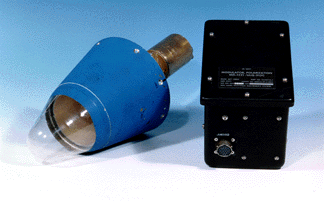
Polarization Modulator
The 100 W continuous wave traveling wave tube amplifier (TWTA) provides the final
high power amplification of the ULQ-21 ECM signal before transmission.

Traveling Wave Tube Amplifier
The microwave power module (MPM) is the result of an effort to miniaturize the
most common module, the I/J-Band TWTA. The MPM is a hybrid amplifier that
utilizes the strong points of both solid-state and vacuum technology to provide
the final stage power amplification. The MPM is currently planned to be used
with the smaller subscale targets like the BQM-74 and the MQM-107. The I-Band
MPM increases the smaller targets' I-Band RF power from 2 W to 100 W.
Development of an E/F-Band MPM will begin in FY-96.
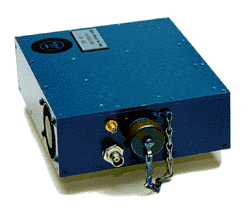
Microwave Power Module
The 2 W solid-state RF amplifier (SSA) is used in place of the 100 W TWTA when a
lower output power is required due to prime power or space limitations. The SSA
produces the necessary gain and RF power needed to provide a deception jamming
capability for smaller subscale targets.
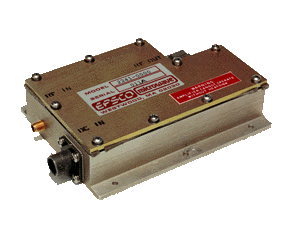
2-Watt Solid-State RF Amplifier
The memory modulator (MM) has the capability to receive a coherent or noncoherent
radar signal, store the signal, and accurately reproduce the RF signal. The
techniques generated by the I/J-Band MM include both RGS and coordinated velocity
gate stealer in addition to range false targets and stretched pulse techniques.
The E/F-Band MM generates only RGS techniques.

I/J-Band Memory Modulator
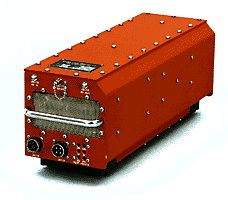
E/J-Band Memory Modulator
As a programmable set-on radar receiver/transmitter (RT), the RT is designed for
a minimum measurement and set-on time. Although useful against all types of
I-band radars, its primary function is to operate against frequency agile radars.
It is designed for operation in the 9.0 to 10.4 GHz range, with a maximum
sensitivity of -55 dBm. Its key feature is a set-on time of less than 250 ns.
In addition, it has the ability to sort multiple radars on the basis of RF
frequency and pulse repetition interval using a programmable RF library. The RT
can be incorporated into the ULQ-21 system, or it can be used as a stand-alone
device for specialized applications and laboratory testing.
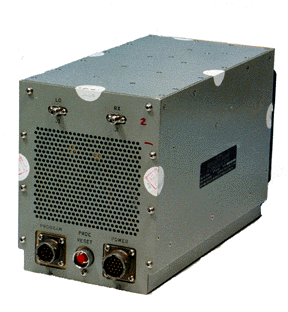
Set-On Radar Receiver/Transmitter
The velocity deception amplifier (VDA) provides the preamplification for the
noise and deception modes and generates deception and AM techniques. The
amplifier provides the preamplification needed to deliver the required RF level
to the 100 watt (W) traveling wave tube amplifier (TWTA) so that sufficient
output power and gain are attained.
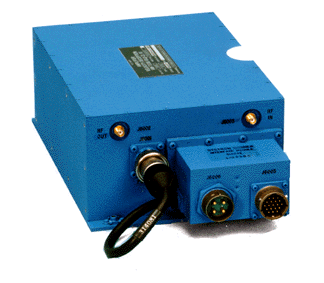
Velocity Deception Amplifier
The multiple technique deception amplifier (MTDA) is a multiple channel,
computer-controlled ECM technique generator. The amplifier is capable of
combining three independent RF signals into a single ECM output. In addition,
the amplifier is capable of applying multiple ECM modulations including
frequency, phase, and AM to all three channels. The amplifier covers the 850 MHz
to 18 GHz frequency region in three bands. This unit will be utilized in both
full-scale and subscale aerial targets, as well as on manned aircraft.
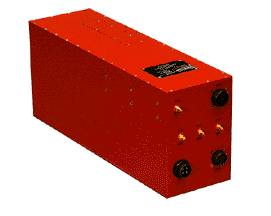
Multiple Technique Deception Amplifier
The waveform-controller oscillator (WCO) is fully programmable and controls up to
three ULQ-21 modules at a time. It produces amplitude modulation (AM) and noise
techniques and is used to detect incoming radio frequency (RF) pulses for the
internally generated transponder range gate stealer (RGS)/false target
techniques. After RF detection, the WCO generates either a fixed or a variable
amount of delay and retransmits a pulse of noise (false target). The WCO can
contain either an RF synthesizer (Type III, 9.0 to 10.5 GHz), a voltage
controlled oscillator (VCO) (5 types, 1 to 18 GHz), or a triple VCO (5 types, 1
to 18 GHz) as the RF source.
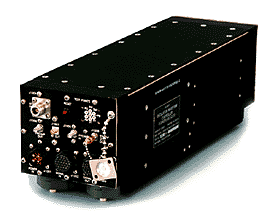
Waveform Controller Oscillator
The command interface unit (CIU) provides control of various individual modules
when a WCO is not required. The CIU provides repeater saturation path and 100 W
saturation path attenuator functions for system gain control.
The frequency translator (FT) is capable of receiving all microwave signals
throughout the weapon system frequency region (1 to 18 GHz). Once the FT
receives the signal, it is translated into one of two narrow frequency bands to
allow other ULQ-21 units (i.e., RT and MM) to receive the signal and operate in
their existing frequency bands. Finally, the units return the signal to the FT
where the signal is coherently translated back to the original frequency band for
retransmission.
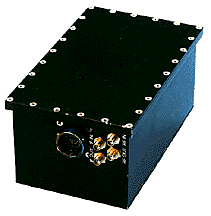
Frequency Translator
The Range Gate Stealer (RGS) Box produces range gate pull-off (RGPO) technique.
It operates from 9 to 10.1 GHz
NOISE GENERATOR
The noise generator is a bench adjustable microwave noise source. The generator
can operate in frequency bands from 1 to 18 GHz; the frequency band is determined
by the voltage controlled oscillator installed. The noise generator has seven
remotely selectable modes: standby, noise spot, barrage noise, frequency comb,
swept noise spot, swept barrage noise, swept frequency comb. The generator is
temperature compensated and is designed for use in small drones; the power
requirement is less than 9 watts from a 28 VDC power source.
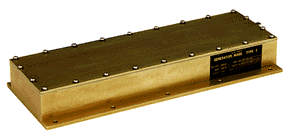
Noise Generator
Adaptive Cross Polarization
There are two types of cross polarization techniques used, adaptive and
nonadaptive. The new adaptive cross polarization system determines the
polarization of the incoming signal and then retransmits the signal with an
orthogonal (cross) polarization. Adaptive cross polarization is an improvement
over nonadaptive since nonadaptive systems can only assume the polarization of
the incoming signal and then retransmit a signal that is swept about the
orthogonal of the assumed polarization.
Special Transmit Antenna
The special transmit antenna (STA) can be used with the ULQ-21 to perform terrain
bounce of the transmitted ECM signal. The antenna does not generate any ECM
techniques, but provides specialized radiation pattern characteristics. There
are three types of STAs. Both Types I and II can be used on the AN/ALQ-167(V)
(ALQ-167) pod and on full-scale and subscale aerial targets. Whereas, Type III
is used specifically on the MQM-8 aerial target.
DEVELOPMENT MODULES
ADVANCED NOISE GENERATOR
The advanced noise generator will add reprogrammability, various amplitude
modulations, and RF power level adjustments to the current noise generator.
IFM NOISE ALTERNATIVE
The instantaneous frequency measurement (IFM) noise alternative module combined
with the other miniaturized modules will enable the smaller subscale targets to
provide the same I-Band noise capability as that currently being provided by the
larger fullscale targets.
ADVANCED VDA
The advanced velocity deception amplifier (VDA) will be both a miniaturization of
the existing VDA and an upgrade of the technique generation capabilities in order
to provide advanced ECM environments.
MINIATURE RGS BOX/RECEIVER
When combined with the advanced VDA and I-Band MPM, the miniaturized RGS/Receiver
will provide the target with the capability to generate replica grade jamming of
specific threat systems.
MINIATURE PM CONTROLLER
Miniaturization of the polarization modulator controller will allow the addition
of the cross-polarization technique capability to the target.
RADIO FREQUENCY SYNTHESIZER
The RF synthesizer is similar to the VCO. It is a continuous wave (CW) RF
generator used to generate RF noise. The output frequency can be programmed
locally using four manually controlled, binary-coded-decimal switches located on
the side. In addition, it can also be remotely programmed via a serial digital
interface. When used in the ULQ-21, the synthesizer utilizes a data bus to
control the frequency of the RF noise signal.
VCO
The voltage controlled oscillator, installed in the WCO, generates an RF signal
that is used to produce ECM techniques. The output frequency range is 1 to 18
GHz.
TVCO
The triple voltage controlled oscillator (TVCO) generates three independent RF
signals through one output port in a single package. Installed in the WCO, the
TVCO is used in producing sophisticated ECM noise techniques in a frequency range
of 850 MHz to 18 GHz in 5 bands. Its outputs can be independently adjusted
across a particular band.
KA-BAND
Due to the continued evolution in weapon systems technology, the ATST initiated a
program to develop and test a threat simulation system that would operate in the
33 to 36 GHz (Ka-Band) frequency range. The Ka-Band/ULQ-21 system that was
developed is capable of generating all of the current countermeasures techniques,
except antenna based techniques.
The integration of the Ka-Band modules with proven ULQ-21 I-Band modules provides
Ka-Band threat simulation without the need to develop specific Ka-Band ECM
equipment. A key element required for Ka-Band threat simulation is the up/down
converter. This converter is capable of converting Ka-Band signals down to the
I-Band frequency range and converting a modulated I-Band signal up to the
original Ka-Band frequency range. Another module included in the Ka-Band system
is the Ka-Band traveling wave tube amplifier. The Ka-Band system also includes a
Ka-Band antenna. The ULQ-21 modules used with the Ka-Band modules are the WCO,
RF synthesizer, VDA, and WG. The complete Ka-Band/ULQ-21 system has a maximum
gain of 87 dB and an effective radiated power of 3.2 kW.
Ka-Band Up/Down Converter
The central component of the Ka-Band/ULQ-21 system is the up/down converter.
This component converts signals in the 33 to 36 GHz (Ka-Band) region down to the
8 to 11 GHz (I-Band) region by using a 25 GHz local oscillator. Use of this
single local oscillator provides accurate reproduction of the Ka-Band center
frequency and ensures coherency. After the appropriate ECM modulations have been
applied in the I-Band ULQ-21 CM set, the converter than reconverts the I-Band
signal back to the Ka-Band. The up/down converter allows the Ka-Band system to
make use of I-Band components already in production. This converter was designed
to fit in the equipment tray of the ALQ-167, allowing complete interface with the
current pod components.
Ka-Band Traveling Tube Amplifier
The Ka-Band TWTA is the final stage, high power amplifier used prior to
transmission of the Ka-Band signal. This TWTA was designed to operate between 32
and 36 GHz and will provide an RF output of 80 W across this frequency range.
This TWTA was also designed to allow remote monitoring of the CM sets' three
states of operation: standby, operate, and fault.
Ka-Band Antenna Group
The Ka-Band antenna group consists of a pair of linear low gain antennas and a
pair of linear high gain antennas. Externally these antennas appear identical
and were designed to fit into the standard antenna arms of the ALQ-167. Both
sets of antennas can be positioned with vertical, horizontal, or slant linear
polarization.
The linear low gain antenna group was designed to produce a minimum gain of 10 dB
with an antenna beamwidth of 50 degrees. The linear high gain antenna group was
designed to produce a minimum gain of 16 dB with an antenna beamwidth of 25
degrees.
Sources and Resources
http://www.fas.org/man/dod-101/sys/ac/equip/.htm
Maintained by Robert Sherman
Originally created by John Pike
Updated Saturday, January 09, 1999 10:27:01 AM


















